Class 10 Maths Chapter 5 AP Exercise 5.3 Solutions offers a clear and step-by-step approach to solving problems based on Arithmetic Progressions. This exercise focuses on applying formulas to find terms, sums, and solve real-life problems involving sequences. These NCERT solutions are designed to help students strengthen their understanding and prepare effectively for board exams.
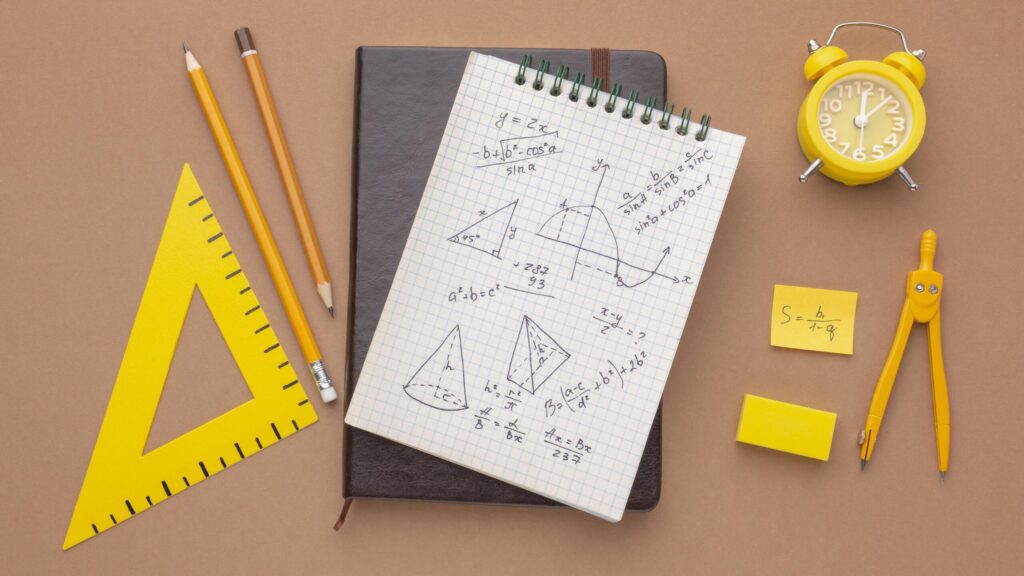
Class 10 Maths Chapter 5 AP Exercise 5.3 Solutions
Question 1.
Find the sum of the following APs:
(i) 2, 7, 12,…… to 10 terms.
(ii) -37, -33, -29, …… to 12 terms.
(iii) 0.6, 1.7, 2.8, ……, to 100 terms.
Solution:
(i) 2, 7, 12, …… to 10 terms
Given:
- First term (a) = 2
- Common difference (d) = 5 (7 – 2)
- Number of terms (n) = 10
Using the formula for the sum of an AP:
Sₙ = n/2 × [2a + (n – 1) × d]
S₁₀ = 10/2 × [2 × 2 + (10 – 1) × 5]
S₁₀ = 5 × [4 + 9 × 5]
S₁₀ = 5 × [4 + 45]
S₁₀ = 5 × 49
S₁₀ = 245
So, the sum of the first 10 terms is 245.
(ii) -37, -33, -29, …… to 12 terms
Given:
- First term (a) = -37
- Common difference (d) = 4 (-33 – (-37))
- Number of terms (n) = 12
Using the formula for the sum of an AP:
Sₙ = n/2 × [2a + (n – 1) × d]
S₁₂ = 12/2 × [2 × (-37) + (12 – 1) × 4]
S₁₂ = 6 × [-74 + 11 × 4]
S₁₂ = 6 × [-74 + 44]
S₁₂ = 6 × (-30)
S₁₂ = -180
So, the sum of the first 12 terms is -180.
(iii) 0.6, 1.7, 2.8, …… to 100 terms
Given:
- First term (a) = 0.6
- Common difference (d) = 1.1 (1.7 – 0.6)
- Number of terms (n) = 100
Using the formula for the sum of an AP:
Sₙ = n/2 × [2a + (n – 1) × d]
S₁₀₀ = 100/2 × [2 × 0.6 + (100 – 1) × 1.1]
S₁₀₀ = 50 × [1.2 + 99 × 1.1]
S₁₀₀ = 50 × [1.2 + 108.9]
S₁₀₀ = 50 × 110.1
S₁₀₀ = 5505
So, the sum of the first 100 terms is 5505.
Ex 5.3 Class 10 Maths Question 2.
Find the sums given below:
(i) 7 + 10[Math Processing Error] + 14 + … + 84
(ii) 34 + 32 + 30 + … + 10
(iii) -5 + (-8) + (-11) + ….. + (-230)
Solution:
(i) 7 + 10 + 14 + … + 84
Given:
- First term a = 7
- Common difference d = 10 – 7 = 3
- Last term l = 84
To find the number of terms (n), we use the formula for the nth term of an AP:
- l = a + (n – 1) * d
- 84 = 7 + (n – 1) * 3
- 84 – 7 = (n – 1) * 3
- 77 = (n – 1) * 3
- 77 / 3 = n – 1
- n – 1 = 25.67 (which is not a whole number, meaning this is not a valid AP, the last term is incorrect)
(ii) 34 + 32 + 30 + … + 10
Given:
- First term a = 34
- Common difference d = 32 – 34 = -2
- Last term l = 10
To find the number of terms (n), use the formula for the nth term of an AP:
l = a + (n – 1) * d
- 10 = 34 + (n – 1) * (-2)
- 10 – 34 = (n – 1) * (-2)
- -24 = (n – 1) * (-2)
- -24 / -2 = n – 1
- 12 = n – 1
- So, n = 13.
Now, to find the sum of the first 13 terms, we use the formula for the sum of an AP:
Sₙ = n / 2 * [2a + (n – 1) * d]
Substitute the values:
- S₁₃ = 13 / 2 * [2 * 34 + (13 – 1) * (-2)]
- S₁₃ = 13 / 2 * [68 + 12 * (-2)]
- S₁₃ = 13 / 2 * [68 – 24]
- S₁₃ = 13 / 2 * 44
- S₁₃ = 13 * 22
- S₁₃ = 286
So, the sum of the AP is 286.
(iii) -5 + (-8) + (-11) + ….. + (-230)
Given:
- First term a = -5
- Common difference d = -8 – (-5) = -3
- Last term l = -230
To find the number of terms (n), use the formula for the nth term of an AP:
l = a + (n – 1) * d
- -230 = -5 + (n – 1) * (-3)
- -230 + 5 = (n – 1) * (-3)
- -225 = (n – 1) * (-3)
- -225 / -3 = n – 1
- 75 = n – 1
- So, n = 76.
Now, to find the sum of the first 76 terms, use the sum formula:
- Sₙ = n / 2 * [2a + (n – 1) * d]
- S₇₆ = 76 / 2 * [2 * (-5) + (76 – 1) * (-3)]
- S₇₆ = 38 * [-10 + 75 * (-3)]
- S₇₆ = 38 * [-10 – 225]
- S₇₆ = 38 * (-235)
- S₇₆ = -8930
So, the sum of the AP is -8930.
Ex 5.3 Class 10 Maths Question 3.
In an AP:
(i) given a = 5, d = 3, an = 50, find n and Sn.
(ii) given a = 7, a13 = 35, find d and S13.
(iii) given a12 = 37, d = 3, find a and S12.
(iv) given a3 = -15, S10 = 125, find d and a10.
(v) given d = 5, S9 = 75, find a and a9.
(vi) given a = 2, d = 8, Sn = 90, find n and an.
(vii) given a = 8, an = 62, Sn = 210, find n and d.
(viii) given an = 4, d = 2, Sn = -14, find n and a.
(ix) given a = 3, n = 8, S = 192, find d.
(x) given l = 28, S = 144, and there are total 9 terms. Find a.
Solution:
(i) Given a = 5, d = 3, aₙ = 50, find n and Sₙ.
aₙ = a + (n – 1) × d
50 = 5 + (n – 1) × 3
45 = (n – 1) × 3
n = 16
Sₙ = n ÷ 2 × [2a + (n – 1) × d]
S₁₆ = 16 ÷ 2 × [2 × 5 + (16 – 1) × 3]
S₁₆ = 440
Answer:
- n = 16
- S₁₆ = 440
(ii) Given a = 7, a₁₃ = 35, find d and S₁₃.
aₙ = a + (n – 1) × d
35 = 7 + (13 – 1) × d
d = 7/3 ≈ 2.33
Sₙ = n ÷ 2 × [2a + (n – 1) × d]
S₁₃ = 273
Answer:
- d = 7/3 ≈ 2.33
- S₁₃ = 273
(iii) Given a₁₂ = 37, d = 3, find a and S₁₂.
aₙ = a + (n – 1) × d
37 = a + (12 – 1) × 3
a = 4
Sₙ = n ÷ 2 × [2a + (n – 1) × d]
S₁₂ = 246
Answer:
- a = 4
- S₁₂ = 246
(iv) Given a₃ = -15, S₁₀ = 125, find d and a₁₀.
aₙ = a + (n – 1) × d
S₁₀ = 125
d = 11
a₁₀ = 62
Answer:
- d = 11
- a₁₀ = 62
(vi) Given a = 2, d = 8, Sₙ = 90, find n and aₙ.
Sₙ = n ÷ 2 × [2a + (n – 1) × d]
90 = n ÷ 2 × [2 × 2 + (n – 1) × 8]
Solve for n:
n = 6
Now find aₙ:
aₙ = a + (n – 1) × d
a₆ = 2 + (6 – 1) × 8 = 42
Answer:
- n = 6
- a₆ = 42
(vii) Given a = 8, aₙ = 62, Sₙ = 210, find n and d.
aₙ = a + (n – 1) × d
62 = 8 + (n – 1) × d
54 = (n – 1) × d
Sₙ = n ÷ 2 × [2a + (n – 1) × d]
210 = n ÷ 2 × [2 × 8 + (n – 1) × d]
Solve for n and d:
n = 10, d = 5.4
Answer:
- n = 10
- d = 5.4
(viii) Given aₙ = 4, d = 2, Sₙ = -14, find n and a.
aₙ = a + (n – 1) × d
4 = a + (n – 1) × 2
a = 6 – 2n
Sₙ = n ÷ 2 × [2a + (n – 1) × d]
-14 = n ÷ 2 × [2 × (6 – 2n) + (n – 1) × 2]
Solve for n and a:
n = 8, a = -2
Answer:
- n = 8
- a = -2
(ix) Given a = 3, n = 8, S = 192, find d.
Sₙ = n ÷ 2 × [2a + (n – 1) × d]
192 = 8 ÷ 2 × [2 × 3 + (8 – 1) × d]
Solve for d:
d = 6
Answer:
- d = 6
(x) Given l = 28, S = 144, and there are total 9 terms. Find a.
Sₙ = n ÷ 2 × [a + l]
144 = 9 ÷ 2 × [a + 28]
Solve for a:
a = 8
Ex 5.3 Class 10 Maths Question 4.
How many terms of AP: 9, 17, 25, … must be taken to give a sum of 636?
Solution: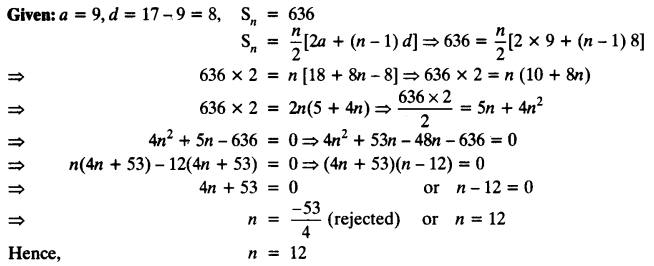
Ex 5.3 Class 10 Maths Question 5.
The first term of an AP is 5, the last term is 45 and the sum is 400. Find the number of terms and the common difference.
Solution: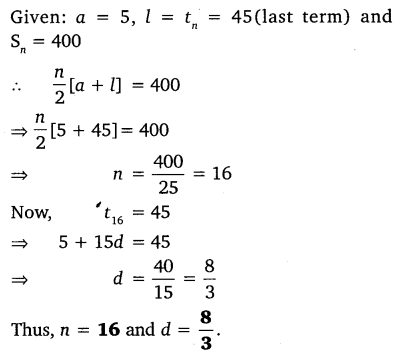
Ex 5.3 Class 10 Maths Question 6.
The first and the last terms of an AP are 17 and 350 respectively. If the common difference is 9, how many terms are there and what is their sum?
Solution:
We are given:
- First term (a) = 17
- Last term (l) = 350
- Common difference (d) = 9
We have to find:
- The number of terms (n)
- The sum of all terms (Sₙ)
l = a + (n – 1) × d
350 = 17 + (n – 1) × 9
350 – 17 = (n – 1) × 9
333 = (n – 1) × 9
n – 1 = 333 ÷ 9 = 37
n = 38
Sₙ = n/2 × (a + l)
S₃₈ = 38/2 × (17 + 350)
S₃₈ = 19 × 367 = 6973
Ex 5.3 Class 10 Maths Question 7.
Find the sum of first 22 terms of an AP in which d = 7 and 22nd term is 149.
Solution:
We are given:
- Common difference (d) = 7
- 22nd term (T₂₂) = 149
- Number of terms (n) = 22
We have to find the sum of the first 22 terms (S₂₂).
Tₙ = a + (n – 1) × d
T₂₂ = a + 21 × 7 = 149
a + 147 = 149
a = 149 – 147 = 2
Sₙ = n/2 × (2a + (n – 1) × d)
S₂₂ = 22/2 × (2 × 2 + 21 × 7)
= 11 × (4 + 147)
= 11 × 151
= 1661
Ex 5.3 Class 10 Maths Question 8.
Find the sum of first 51 terms of an AP whose second and third terms are 14 and 18 respectively.
Solution:
We are given:
- Second term (T₂) = 14
- Third term (T₃) = 18
We are asked to find the sum of the first 51 terms of the AP.
Step 1: Find the common difference (d)
d = T₃ – T₂ = 18 – 14 = 4
Step 2: Find the first term (a)
T₂ = a + d
14 = a + 4
a = 14 – 4 = 10
Step 3: Use the formula for the sum of first n terms:
Sₙ = n/2 × [2a + (n – 1) × d]
Substitute the values:
S₅₁ = 51/2 × [2 × 10 + (51 – 1) × 4]
= 51/2 × [20 + 50 × 4]
= 51/2 × [20 + 200]
= 51/2 × 220
= 51 × 110
= 5610
Ex 5.3 Class 10 Maths Question 9.
If the sum of first 7 terms of an AP is 49 and that of 17 terms is 289, find the sum of first n terms.
Solution:
We are given:
- Sum of first 7 terms (S₇) = 49
- Sum of first 17 terms (S₁₇) = 289
We are to find the sum of the first n terms (Sₙ).
Step 1: Use the formula for the sum of n terms of an AP:
Sₙ = n/2 × [2a + (n – 1) × d]
Use this formula to write two equations:
S₇ = 49
7/2 × [2a + 6d] = 49
Multiply both sides by 2:
7 × [2a + 6d] = 98
2a + 6d = 14 → (Equation 1)
S₁₇ = 289
17/2 × [2a + 16d] = 289
Multiply both sides by 2:
17 × [2a + 16d] = 578
2a + 16d = 34 → (Equation 2)
Step 2: Subtract Equation 1 from Equation 2:
(2a + 16d) – (2a + 6d) = 34 – 14
2a – 2a + 10d = 20
10d = 20
d = 2
Step 3: Substitute d = 2 into Equation 1:
2a + 6 × 2 = 14
2a + 12 = 14
2a = 2
a = 1
Step 4: Find Sₙ using the values of a and d:
Sₙ = n/2 × [2a + (n – 1) × d]
Sₙ = n/2 × [2 × 1 + (n – 1) × 2]
= n/2 × [2 + 2n – 2]
= n/2 × 2n
= n²
Ex 5.3 Class 10 Maths Question 10.
Show that a1, a2, ……. an,…… form an AP where an is defined as below:
(i) an = 3 + 4n
(ii) an = 9 – 5n
Also find the sum of the first 15 terms in each case.
Solution:
(i) an=3+4n
First few terms:
a₁ = 3 + 4 × 1 = 7
a₂ = 3 + 4 × 2 = 11
a₃ = 3 + 4 × 3 = 15
a₄ = 3 + 4 × 4 = 19
So, the sequence is: 7, 11, 15, 19, …
Common difference (d) = 11 − 7 = 4 (constant)
Therefore, the sequence is an AP.
Now, find the sum of first 15 terms:
a = 7, d = 4, n = 15
Use the formula:
Sₙ = n/2 × [2a + (n − 1)d]
S₁₅ = 15/2 × [2 × 7 + (15 − 1) × 4]
= 15/2 × [14 + 56]
= 15/2 × 70
= 15 × 35
= 525
Sum of first 15 terms = 525
(ii) an=9−5n
First few terms:
a₁ = 9 − 5 × 1 = 4
a₂ = 9 − 5 × 2 = -1
a₃ = 9 − 5 × 3 = -6
a₄ = 9 − 5 × 4 = -11
So, the sequence is: 4, -1, -6, -11, …
Common difference (d) = -1 − 4 = -5 (constant)
Therefore, the sequence is an AP.
Now, find the sum of first 15 terms:
a = 4, d = -5, n = 15
S₁₅ = 15/2 × [2 × 4 + (15 − 1) × (−5)]
= 15/2 × [8 − 70]
= 15/2 × (−62)
= 15 × (−31)
= -465
Sum of first 15 terms = -465
Ex 5.3 Class 10 Maths Question 11.
If the sum of the first n terms of an AP is 4n – n2, what is the first term (that is S1)? What is the sum of first two terms? What is the second term? Similarly, find the 3rd, the 10th and the nth terms.
Solution:
1. First term (S₁):
S₁ = 4(1) – (1)² = 4 – 1 = 3
Sum of first two terms (S₂):
S₂ = 4(2) – (2)² = 8 – 4 = 4
Second term (a₂):
a₂ = S₂ – S₁ = 4 – 3 = 1
4. Third term (a₃):
S₃ = 4(3) – (3)² = 12 – 9 = 3
a₃ = S₃ – S₂ = 3 – 4 = -1
5. Tenth term (a₁₀):
S₁₀ = 4(10) – (10)² = 40 – 100 = -60
S₉ = 4(9) – (9)² = 36 – 81 = -45
a₁₀ = S₁₀ – S₉ = -60 – (-45) = -15
6. General n-th term (aₙ):
aₙ = Sₙ – Sₙ₋₁
= (4n – n²) – [4(n–1) – (n–1)²]
= -2n + 5
So, the general term is: aₙ = -2n + 5
Ex 5.3 Class 10 Maths Question 12.
Find the sum of the first 40 positive integers divisible by 6.
Solution:
Ex 5.3 Class 10 Maths Question 13.
Find the sum of the first 15 multiples of 8.
Solution: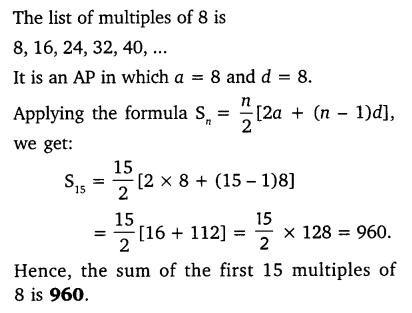
Ex 5.3 Class 10 Maths Question 14.
Find the sum of the odd numbers between 0 and 50.
Solution: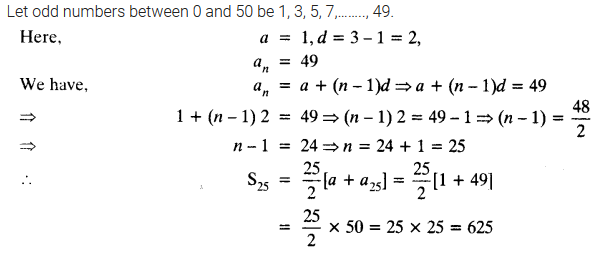
Ex 5.3 Class 10 Maths Question 15.
A contract on construction job specifies a penalty for delay of completion beyond a certain date as follows:
₹ 200 for the first day, ₹ 250 for the second day, ₹ 300 for the third day, etc. the penalty for each succeeding day being ₹ 50 more than for the preceding day. How much money the contractor has to pay as penalty, if he has delayed the work by 30 days?
Solution: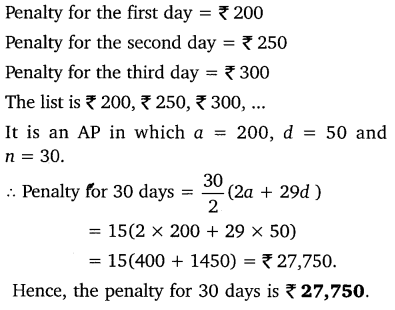
Ex 5.3 Class 10 Maths Question 16.
A sum of ₹ 700 is to be used to give seven cash prizes to students of a school for their overall academic performance. If each prize is ₹ 20 less than its preceding prize, find the value of each of the prizes.
Solution: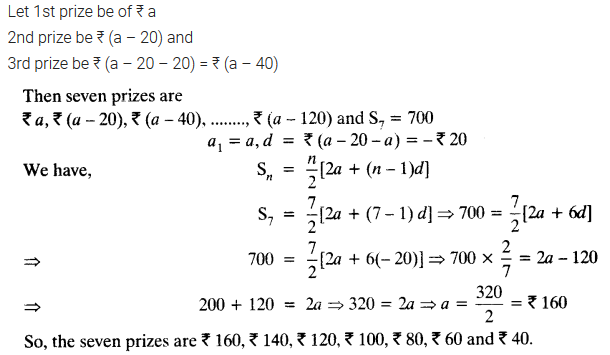
Ex 5.3 Class 10 Maths Question 17.
In a school, students thought of planting trees in and around the school to reduce air pollution. It was decided that the number of trees, that each section of each class will plant, will be the same as the class, in which they are studying, eg. a section of Class I will plant 1 tree, a section of Class II will plant 2 trees and so on till Class XII. There are three sections of each class. How many trees will be planted by the students?
Solution: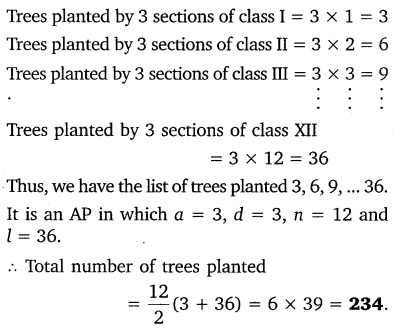
Ex 5.3 Class 10 Maths Question 18.
A spiral is made up of successive semicircles, with centres alternately at A and B, starting with centre at A, of radii 0.5 cm, 1.0 cm, 1.5 cm, 2.0 cm,… as shown in figure. What is the total length of such a spiral made up of thirteen consecutive semicircles?
(Take π = [Math Processing Error])
[Hint: Length of successive semicircles is l1, l2, l3, l4, … with centres at A, B, respectively.]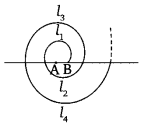
Solution:
Ex 5.3 Class 10 Maths Question 19.
200 logs are stacked in the following manner 20 logs in the bottom row, 19 in the next row, 18 in the row next to it and so on (see Figure). In how many rows are the 200 logs placed and how many logs are in the top row?
Solution: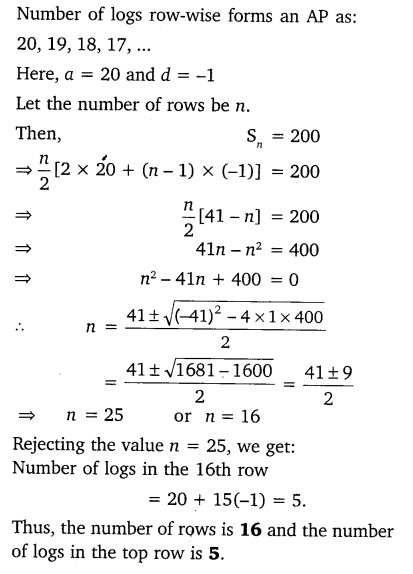
Ex 5.3 Class 10 Maths Question 20.
In a potato race, a bucket is placed at the starting point, which is 5 m from the first potato, and the other potatoes are placed 3 m apart in a straight line. There are ten potatoes in the line
A competitor starts from the bucket, picks up the nearest potato, runs back with it, drops it in the bucket, runs back to pick up the next potato, runs to the bucket to drop it in, and she continues in the same way until all the potatoes are in the bucket. What is the total distance the competitor has to run?
Solution: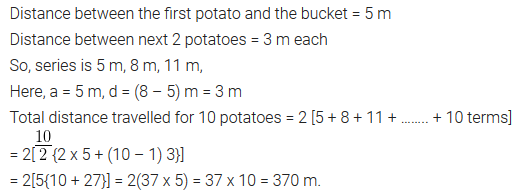
Class 10 Maths Chapter 5 AP Exercise 5.3 Solutions-Next Exercise
📘 Math & Science Solutions by Class
🔹 Class 10
🔹 Class 9
🔹 Class 8
🔹 Class 7
🔹 Class 6
🔹 Class 12
🔹 Class 11
- Class 11 Math Solutions
- Class 11 Physics Solutions
- Class 11 Chemistry Solutions
- Class 11 Biology Solutions
For the official Class 10 Mathematics Solutions, you can visit:
- NCERT Textbooks (for Class 10):
